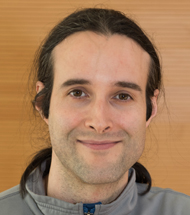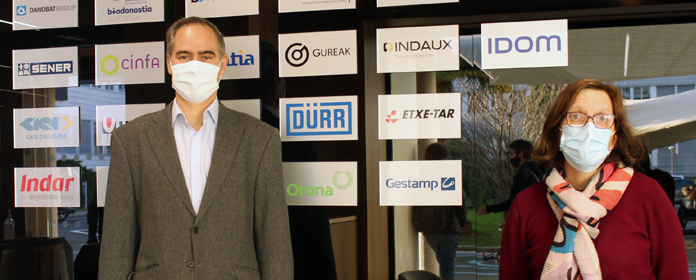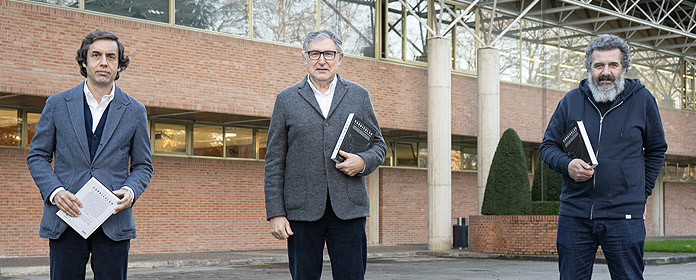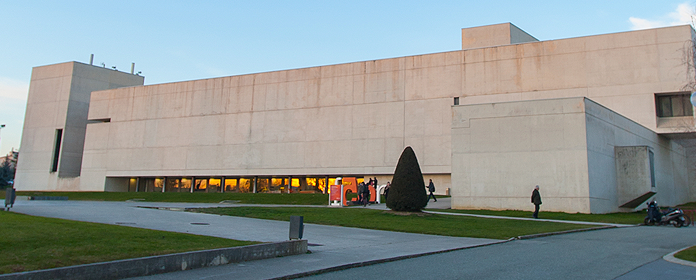Inoculated with the "virus" of the research
The graduate and PhD in Biochemistry by the University of Navarra Iñaki Martín publishes, with his IDIBAPS team, the first functional map of leukemia.

PHOTO: Courtesy
The same day that Iñaki Martín (Bio, Bioq, PhD 01) and his IDIBAPS team appeared on the front page of all the national and many international media, Iñaki did not hesitate to answer the call of his School (School of Sciences, University of Navarra). Our goal was to tell, through his testimony, the story of a graduate in Sciences that with his work -in which also participated specialists of the Clínica Universidad de Navarra and the CIMA- has marked a before and after in the research on leukemia.
But Iñaki was not always so clear about his vocation. In fact, he recognizes that it was at the University where he was "inoculated" with the virus of research."I was a lousy student at high school, until I arrived at the University and academic capacities that I didn't know about were awakened in me. All because of that interest in understanding...".
That's why he recommends students to look for "their motivation":"In this degree program there is always talk of lack of funding; of precariousness, and of little recognition. All of that is true. I myself, until the end of 2016, was living on temporary contracts without knowing if I could stabilize my line of research. In the midst of that uncertainty what never changed was my "reason" to continue," he asserts.
- Could you explain briefly what your finding, published this month in Nature Medicine, has consisted of?
We have generated, for the first time,a high-resolution map of the genome functions of chronic lymphocytic leukemia and healthy B lymphocytes. To achieve this, we have sequenced ten layers of molecular information and eight different epigenetic marks, in addition to the genome and transcriptome of the same patient samples. By integrating all the information using computational tools (i.e. bioinformatics), we were able to create the functional map of leukemia. By comparing the leukemia map with that of healthy lymphocytes, we have been able to decipher the functional changes in the leukemia genome, which will help us financial aid to understand the disease much better and open new avenues for therapeutic strategies.
- Your team has described, for the first time, how cancer cells create their own "super production" centers to make the disease spread in the most efficient way. The more we know about cancer, the more certain we are of its complexity and the need for a personalized approach?
We have found that leukemic cells build large functional areas in regions that had no function in normal cells. These new functional regions are located near genes important for neoplastic growth, and result in overexpression of these genes. This leads to dysregulation of the molecular harmony of the cells and uncontrolled cell proliferation.
The more we investigate, the more we are surprised by the complexity behind this disease. At the same time, however, we see that there is an order behind this complexity. All the factors that contribute to cancer development are intertwined. So the better we understand these molecular mechanisms, the better we can detect the points of vulnerability to develop more targeted and effective treatments.
- What is the relationship between those "switches" that turn genes on and off and those three families of proteins involved in the disease?
The analysis of so many layers of epigenetic information (DNA methylation, chromatin accessibility and six different histone modifications) has allowed us to classify the genome into 12 different functions. By comparing the distribution of these 12 functions in the leukemia genome with that of healthy cells, we found 500 regions that are activated in leukemia. We then investigated the causes of such activation and found that there were three families of transcription factors - called NFAT, FOX and TCF/LEF - with the ability to bind to DNA Closed and open it up, creating gene regulatory functions. In other words: these 3 transcription factors can change the "functional landscape" of healthy cells and transform it into a leukemia-associated landscape.
- Together with experts in Bioinformatics, you are faced with millions and millions of data about the functioning of this cancer subject . Are these same data going to help you to take new steps in the description of leukemia?
Of the 5 years of study, 2 years were devoted to generating data and 3 years to computational programs of study of data analysis. This second part was a huge challenge . We had to learn and develop bioinformatics tools to integrate massive amounts of different data . This, as you can imagine, is not done with a computer staff, but on large supercomputing platforms (we work very closely with the Barcelona Supercomputing Center).
In the end, our study is a seed study that paves the way for further research. All the data generated are available for other researchers to analyze in different and creative ways and draw new conclusions. In addition, we have generated a web page associated with article to share data and to visualize the leukemia map.
- It has been 5 years of work, 51 researchers from 23 organizations from six different countries. Does this study confirm that research either advances in multidisciplinary and multicenter teams, or it does not advance?
During the last few decades there has been a shift in the way research is done, from individual groups to large consortia of research and interdisciplinary collaborations. However, I would not say that science does not advance if there is no collaboration, but rather, if there is collaboration, it advances more. Collaborations are very enriching. Our study has involved clinical specialists in hematology, pathologists, cell biologists, molecular biologists and bioinformaticians. The challenge of collaborating with so many different researchers is to have good organization and communication, and to align with a common goal .
degree program - If you look back, what would you say that your time at classroom at School of Sciences contributed to your professional career? What about doctorate with Professor María José Calasanz?
Between degree program and doctorate, I was at the University for a total of 8 years, from 1993 to 2001. I still feel very attached to campus. In fact, when I return to Pamplona I also visit my friends-collaborators at the University, the Clinic and CIMA.
I met Professor María José Calasanz in the second year of degree program and just that year I joined as teaching assistant at department of Genetics to collaborate with her and her activities in biostatistics and genetic diagnosis of leukemias. That bond of work and friendship is still alive today. If I had to highlight something that I learned in those years -apart from the academic aspects- it would be her lesson that research and teaching, if done while enjoying it, is easier and more effective. With María José I also learned what is involved in partnership based on trust. Things that I have never told her, so she will laugh when she reads this interview...





